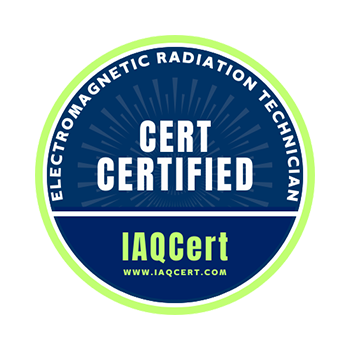Certified Electromagnetic Radiation Technician (CERT)
The Certified Electromagnetic Field and Radiation Technician (CERT) course offers in-depth training in managing EMF and EMR in various environments. The program covers assessment techniques, hazard identification, and mitigation strategies, using advanced tools and data interpretation. Participants learn electromagnetic safety principles for health protection in residential, commercial, and industrial spaces. Graduates gain a solid foundation in EMF and EMR management, ready to enhance community health and safety.
Overview
Certification
As a CERT-certified technician, you’ll deliver professional EMF and EMR safety services that ensure compliance and protection across residential, commercial, and industrial settings.
This Assessment-Based Certificate (ABC) program verifies your technical expertise in identifying, measuring, and mitigating electromagnetic exposure risks while maintaining safe environmental conditions. After passing the exam, you can proudly display your digital IAQCert badge on your website, flyers, or social media to highlight your verified professionalism and commitment to electromagnetic safety.
Learning Approach
1. LearnEase
Ideal for beginners, offering 37 engaging lectures across 10 comprehensive modules. Engage at your own pace and use the extensive material as a valuable resource bank.
Start Learning Now!
2. CertFast
Perfect for experienced professionals. A focused 1-hour exam to validate your skills quickly, bypassing the extended learning modules.
Learning Outcomes
- Understand EMF and EMR and their effects on environments.
- Use tools and methodologies for detecting and assessing hazards.
- Interpret data to develop mitigation strategies.
- Communicate risks and solutions effectively.
- Maintain precise documentation.
- Adhere to current regulations and standards.
- Stay updated with trends and advances in EMF and EMR safety.
Offering both a Comprehensive Learning Path (LearnEase) and a Fast-Track Exam Path (CertFast), our CADCT course equips you with essential skills and knowledge to excel as an Electromagnetic Radiation Technician.
Enrollment & Certification Policy
Your enrollment includes full access to all course materials and the final exam for one year from your original date of enrollment. Certification is awarded immediately upon successfully passing the exam, and it remains valid until one year from your initial enrollment date. Students who enroll in a Technician Certification are eligible to receive one Safety course of their choice free of charge. To redeem this benefit, please contact IAQCert support after completing your Technician course enrollment.
Curriculum
Curriculum
- 10 Sections
- 37 Lessons
- 52 Weeks of Access
- 1.0 Introduction to Electromagnetic Radiation4
- 2.0 Health Effects of Electromagnetic Radiation4
- 3.0 Measurement of Electromagnetic Radiation7
- 4.0 Mitigation and Shielding Techniques6
- 5.0 Legal Standards and Guidelines6
- 6.0 Communication and Consulting Skills3
- 7.0 Case Studies and Practical Applications3
- 8.0 Resources and Continuing Education3
- 9.0 Appendix1
- 10.0 CERT CERTIFICATION EXAM5




